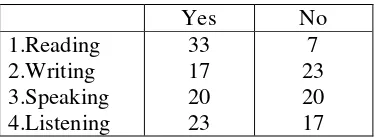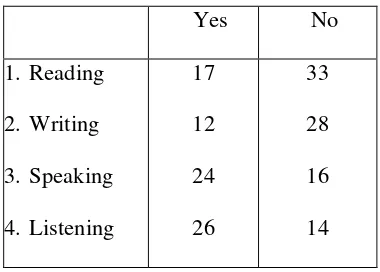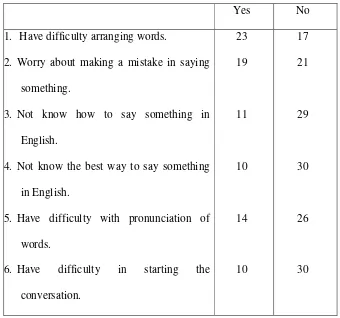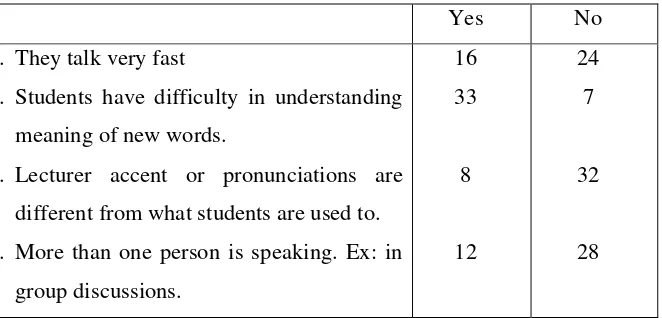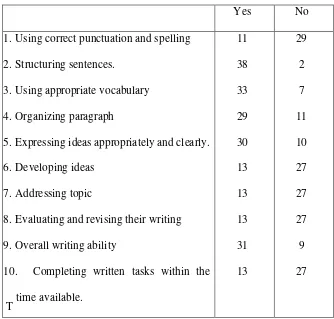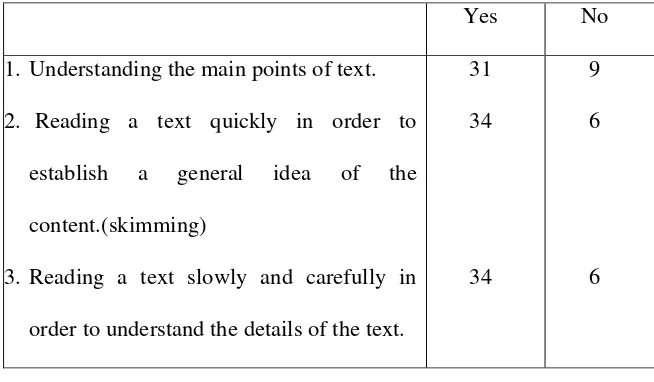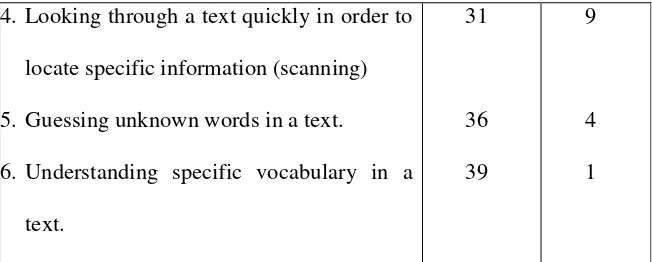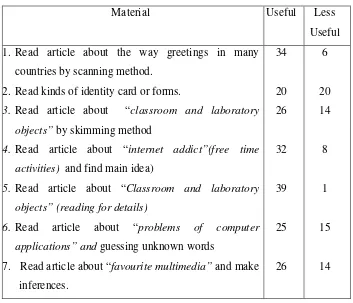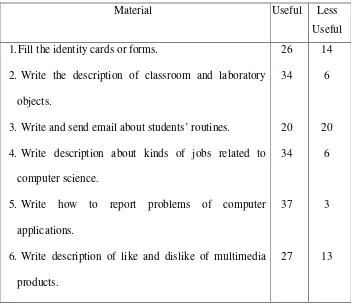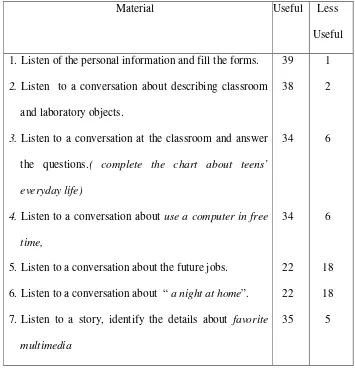CHAPTER IV
RESULTS AND DISCUSSION
In this part the writer presents analysis of curriculum and syllabus of STMIK Amikom Purwokerto. The writer also presents result and discussion of needs analysis and recommends to redesign the syllabus.
A. Results
1. Curriculum
In this section, the writer explained and analyzed curriculum at STMIK Amikom Purwokerto. It was used to know the goal and objectives of the educational system and to make decisions in syllabus design. English program at STMIK Amikom Purwokerto is a compulsory for all students. It is consists of three parts: Bahasa Inggris 1,Bahasa Inggris 2 and Bahasa Inggris 3, with the total credits are six. The main goal of English program is to make the students have a good skill in English.
English program taught to the students how to express themselves in English. It gives students more practices to speak English in many useful activities and for many important purposes. It also emphasizes on four basic skills; listening, speaking, reading and writing and the students would learn grammar functionally to communicate with others.
1. To teach the oral skill needed to express and understand a basic core of topics and communicative function in English. 2. To teach basic writing skills for a range of functional tasks. 3. To teach extensive and intensive reading skills.
4. To provide a variety of interesting learning experiences relevant of intermediate level learners.
The writer analyzed of STMIK Amikom curriculum based on the data above. The writer divided three parts of analysis. First, the ideology of the curriculum is social –efficiency approach because the curriculum focuses on knowledge and skills that are relevant to the learner’s everyday life needs and that the curriculum should be planned to meet the practical needs of society.
Second analysis was about the objectives of the curriculum. According to Keputusan menteri pendidikan nasional No.232/U/2000 (http://www.lpp.uns.ac.id/download/2010/BUKU%20Panduan%20KBK %20DIKTI.pdf) defines a curriculum as;
”Kurikulum pendidikan tinggi adalah seperangkat rencana dan pengaturan mengenai isi maupun bahan kajian dan pelajaran serta cara penyampaian dan penilaian yang digunakan sebagai pedoman penyelenggaraan kegiatan belajar-mengajar di perguruan tinggi.”
order successfully to build house. So, the objectives of the curriculum play a major role to reach the goal of the program. Then the writer concludes that the objectives of English Program at STMIK Amikom Purwokerto are focused to comprehend four basic skill of English; listening, speaking, reading and writing.
The last, it is about what kind of Amikom curriculum is. Based on the objectives above, it is clear enough that the curriculum refers to Competency- based because the institution emphasizes on comprehension of four basic skills of Englisht and expected to master in relation to specific situations and activities.
Competence-based curriculum is a systemic framework. This means that build all the supporting competencies such as linguistic competence, sociocultural, competence strategic and discourse. This means that language teaching does not depart from the question "What material should I teach today?", But "what competencies must be obtained today?" The materials required to support this curriculum is not limited to what is called a "text book". Accordingly, the English-language sources of any kind, as far as it can support acquisition of competence should be used, and teachers should not be glued to a textbook.
2. Syllabus
and learning process, so it should be made as consciously and with as much information as possible. The writer decided two parts of analysis; 1. Format Analysis
Bahasa Inggris 1 syllabus from the institution is divided into six columns (the syllabus is enclosed on the appendix 3). They are:
(a) Meeting
(b)Topic (general instructional objectives) (c) Sub Topic (specific instructional objectives) (d)Learning Techniques
(e) Learning Media (f) References
On the other hand, Bharati at Teachers’ Professional Development through an Observation in Immersion Classes Based on the Documents and Teaching and Learning Processes, 2009:10,11) explained that the format of syllabus should be seven columns and follow the steps in constructing the syllabus are as follows:
(1) Observing that the competence standard should be in line with the basic competence; they should be in a good hierarchy,
(2) Constructing the potential main material, (3) Arranging the learning activities,
(4) Deciding the indicators, (5) Evaluating the plan,
There are some elements that should be improved in
Bahasa Inggris 1 syllabus of STMIK Amikom Purwokerto especially for improving standard and basic competence, sequencing materials, learning activities, indicators, evaluation and time allotment.
2. Content Analysis
In this section, the writer analyzes the content of Bahasa Inggris 1 syllabus from STMIK Amikom Purwokerto. Based on the Amikom English Teachers questionnaire (see on appendix 1), the writer concludes that there are some weaknesses of the syllabus content;
The teachers find difficulties to read the syllabus because
- The syllabus does not include standard competence and basic competence that would be reached.
- The materials are not sequenced well, so it would make the teacher difficult to develop.
- The materials are not in line with learning activities, indicators and evaluations.
- Learning activities tends to be the same in every meeting.
- The syllabus does not include explanation about time allotment, types, form and instrument of the test.
STMIK Amikom Purwokerto. The improvements consider eight points of syllabus development:
1. Assessing and Determining Competency Standards.
Assessing the competency standards and focusing to the following matters:
a. Sequence level of difficulty of material.
b. The competence standards and basic competence must be in line;
2. Assessing and Determining the Basic Competence
Assessing the competency standards and focusing to the following matters:
a. Sequence level of difficulty of material.
b. The competence standards and basic competence must be in line;
3. Identifying Basic Materials We have to consider: a. Potential learners; b. usefulness for learners;
c. Actuality, the depth and breadth of learning materials; d. Relevance to the needs of learners and the demands of the
4. Developing Learning Activities
Learning activities were designed to provide learning experiences through interaction between learners, learners with teachers, environmental, and other learning resources in the achievement of competences. The learning experience is to be realized through a variety of learning approaches and centered on the learner. Learning experience includes life skills that learners need to be mastered.
Things that should be developed in learning activities:
a. Containing sequence activities to achieve basic competency.
b. Determining the sequence of learning activities and must comply with the concept of learning materials.
c. The formulations of the learning activities at least contain two elements that reflect the management of the learning experience of students. Those are the students' activities and materials.
5. Formulating Indicators.
verbs that can be measured and / or observed. Level verb in the indicator is lower than or equivalent to the verb in the KD and SK. Principles of indicator development are in accordance with the interests of (Urgency), continuity (Continuity), appropriateness (relevance) and Contextual.
6. Determining Types of Evaluation.
Evaluation is a series of activities to acquire, analyze, and interpret data about the process and learning outcomes of students who performed in a systematic and continuous, so that it becomes meaningful information in decision making. Assessment carried out by using tests and non-test in the form of written or oral, observation of performance, attitude, use of portfolios, and self-assessment.
7. Determining the Time Allocation.
syllabus is the approximate average time to master the basic competencies required by learners are diverse.
8. Determining the Source of Learning Learning is a source, object and / or materials used for learning activities. Learning resources can be either printed and electronic media, resource persons, as well as the physical environment, natural, social, and cultural. Determination of learning resources is based on the standards of competence and basic competencies and subject matter / learning, learning activities, and indicators of achievement of competencies.
There were some revisions with reference to Competence Based Curriculum of Bahasa Inggris 1 of STMIK Amikom Purwokerto. The revisions are;
(a) General Objective:
Have good English skills especially to communicate with others in Information System context.
(b) Standard Competence: Listening:
Express ideas in simple transactional and interpersonal to the environment nearby.
Reading
Understand the meaning of the short functional text related in the environment nearby.
Writing
Express ideas in short functional text related to the environment nearby.
(c) Materials
The writer must be careful in selecting and sequencing material because this is one of the most essential parts of syllabus design. The writer decides to find out as many references as possible to get appropriate material of English for Information System (Computer Science). The writer combines the materials from Amikom Textbook and Snow and Kamhi-Stein (2006:43-47). The writer selects Kamhi-Stein model because of some reasons.
1. Kamhi and Stein already conducted the study at University course in Spain about English syllabus for computer science .
Dealing with selecting materials, the writer decides to offer to the students by giving them needs analysis questionnaire. The result of students’ needs analysis that would be explained on part C (Result of Needs Analysis).
(d) Learning activities
We can organize the real-life experiences based on literacy. Literacy or the quality of being literate of university students is in epistemic level. It means they use English for transforming language and experience. Transforming is the use of language in certain context (Information System). It gets students to talk about the experience, share their observation, react feeling.
The writer integrated the experience in four skills by organizing materials and learning experiences into spoken cycle (listening and speaking) and written cycle (reading and writing) (diklat PPPG: 34,37). More over the writer organized activities in every cycle into four stages (building knowledge of the field, modeling of text, joint construction, independent construction)
The writer used the teaching and learning cycle adapted from Callaghan and Rothery, 1998. (Burns and Joyce, 1992:17).
classroom tasks and activities and are related to the starting points of topic.
The four stages are:
Stage one: Building Knowledge of Field (BKOF) Stage two: Modeling of Text (MOT)
Stage three: Join Construction of Text (JCOT)
Stage four: Independent Construction of Text (ICOT)
The writer creates learning activities that can give the real-experiences to student, included add some fun activities at learning process.
(e) Indicators and Evaluations
Indicators are made in line with materials, learning activities and evaluations.
(f) Time allotment
Time allotment is a hundred minutes per meeting.
3. Students’ Needs in Learning English
a. Overview of skills needed and difficulties encountered
Number of the sample is 40 students. The questionnaires gave to the students at the classroom in STMIK Amikom Purwokerto. Table 4.1 The students expect to use skills:
The writer concludes that there are more than 17 until 33 students expect to use reading skill, although there are other skills that they want to learn.
Table 4.2 Students’ difficulties at four skills
Yes No
1. Reading 2. Writing 3. Speaking 4. Listening
17 12 24 26
33 28 16 14
1. Speaking Skill
Table 4.3 Students’ problems in speaking skill
Yes No
1. Have difficulty arranging words.
2. Worry about making a mistake in saying
2. Listening Skill
Table 4.4 Students’ problems in listening skill
Yes No
1. Have to ask friends to clarify material, the lecture has been taught.
2. Have trouble understanding lengthy descriptions in English.
3. Have trouble understanding spoken instructions.
Table 4.5 Students’ problems of understanding lecturers or other students because:
Yes No
4. They talk very fast
5. Students have difficulty in understanding meaning of new words.
Second is the problem of listening skill, when they were at class, they encountered several obstacles, such as;
1. Students have trouble in understanding meaning of new words. 2. Students have to ask friends to clarify material that has been taught.
3. Writing Skill
Table 4.6 Students’ problem in writing skill.
T
The third is the problem of writing skill. The writer found five majors problems of the students;
- Structuring sentences.
Yes No
1.Using correct punctuation and spelling 2.Structuring sentences.
3.Using appropriate vocabulary 4.Organizing paragraph
5.Expressing ideas appropriately and clearly. 6.Developing ideas
7.Addressing topic
8.Evaluating and revising their writing 9.Overall writing ability
- Using appropriate vocabulary - Organizing paragraph
- Expressing ideas appropriately and clearly. - Overall writing ability
4. D. Reading Skill
Table 4.7 Students are expected to read:
Expected to read
1. Journal Article
2. Newspaper /magazine article 3. Works of fiction
4. Selected chapters of books 5. reading materials from internet
15 38 27 32 29
Table 4.8 Students’ problems in reading skill:
Yes No
1. Understanding the main points of text. 2. Reading a text quickly in order to
establish a general idea of the content.(skimming)
3. Reading a text slowly and carefully in order to understand the details of the text.
4. Looking through a text quickly in order to locate specific information (scanning) 5. Guessing unknown words in a text.
6. Understanding specific vocabulary in a text.
The fourth is to analyze students’ reading skill. The students have a high reading interest and the students pay much attention in reading
b. Overview of topics needed
Table 4.9. Overview of topics is needed to decide the topics that will be compiled in syllabus.
Topic for 1st Semester Useful Less Useful 1. Introduction & greeting (online communication)
2. Classroom and laboratory objects (hardware)
4. Occupation & workplaces (the future job of computer science)
5. Looking back : Problems of computer applications 6. Favorite multimedia: Music, movies, sport, TV
programs, games.
36
37 30
4
3 10
For overview of students’ topic needed, the writer gave seven topics that were taken from the Amikom’s handbook and also related sources. There are 30-37 students choosing all the topics which are useful for them.
c. Communicative Competence Components:
The writer took some teaching material from Amikom handbook, related sources and has already adapted them to the curriculum and available time allotment. The writer provides the teaching materials for specific purpose especially English for Information System Students.
1. Skills a. Reading
Table 4.10 Students’ need for reading
Material Useful Less
Useful 1. Read article about the way greetings in many
countries by scanning method. 2. Read kinds of identity card or forms.
3. Read article about “classroom and laboratory objects” by skimming method
4. Read article about “internet addict”(free time activities) and find main idea)
5. Read article about “Classroom and laboratory objects” (reading for details)
6. Read article about “problems of computer applications” and guessing unknown words
7. Read article about “favourite multimedia” and make inferences.
table above, around 20 up to 39 students would like to read all reading materials.
b. Writing
Table 4.11 Students’ need for writing
Material Useful Less
Useful 1.Fill the identity cards or forms.
2. Write the description of classroom and laboratory objects.
3. Write and send email about students’ routines.
4. Write description about kinds of jobs related to computer science.
5. Write how to report problems of computer applications.
6. Write description of like and dislike of multimedia products.
26 34
20 34
37
27
14 6
20 6
3
13
c. Listening
Table 4.12 Students’ need for listening
Material Useful Less
Useful 1. Listen of the personal information and fill the forms.
2. Listen to a conversation about describing classroom and laboratory objects.
3. Listen to a conversation at the classroom and answer the questions.( complete the chart about teens’ everyday life)
4. Listen to a conversation about use a computer in free time,
5. Listen to a conversation about the future jobs. 6. Listen to a conversation about “ a night at home”.
d. Speaking
Table 4.13 students’ need for speaking
Material Useful Less
Useful 1. Personal introduction and giving personal information.
2. Describe the function of classroom and laboratory objects.
3. Describe weekly routines.
4. Describe a job related to computer science.
5. Report the problems about computer applications. 6. Describe students’ like and dislike
32
The writer concludes that there are 24- 30students expectingt to use all the materials of speaking skill.
2. Linguistic features a. Grammar
Table 4.14 students’ need for grammar material
Material Useful Less
Useful 1. Subject pronoun (They, We, I, You, He, She, It), to be
in short sentences and Yes/No questions.
2. Singular and plural noun, countable and uncountable 39
37
1
noun and articles a, an, the and quantifiers. 3. Simple present tense and adverbs of frequency. 4. Possessive adjective ex; my, his, your.
5. Cohesion devices for situational context. • Personal my friend, we, you, him, ...) • Spatial (here, there; this, that)
Temporal (now, then; after, before) 6. Simple future
7. Simple Past tense 8. Present Continuous
34
The writer concludes that there are 34-39 students expecting to use all the materials of grammar.
b. Punctuations
Table 4.15 Students’ need for punctuations materials
Material Useful Less
Useful 1. Use capital letters and periods in paragraph.
2. Use marker (!,?) for imperative and interrogative sentences.
The writer concludes that there are 31-34 students expecting to use all the materials of punctuation.
c. Expressions
Table 4.16 Students’ need for expression materials
Material Useful Less
Useful 1. Expression to say hallo, goodbye and everyday
expression
2. Use personal information expression. 3. Use place or location expression. 4. Use time expression for routines. 5. Use time expression for the past. 6. Use like and dislike expression.
30
The writer concludes that there are 30-35 students expecting to use all the materials of Expressions.
d. Vocabularies
Table 4.17 Students’ need for vocabulary materials
Material Useful Less
Useful 1. Meeting and greeting in on line communication
2. Classroom and laboratory objects
31 36
3. Activities in free time.
4. Kind of jobs, work places, job description 5. Adjective for describing computer problems
6. Kind of multimedia application example: music and sport.
The writer concludes that there are 29-38 students expecting to use all the materials of vocabularies.
e. Pronunciation, intonation, stress and spelling
Table 4.18 Students’ needs for pronunciation, intonation, stress and spelling materials.
Material Useful Less
Useful
1. Spelling name, phone no, and e-mail address
2. S ending for plural noun : /s/,/z/,/iz/
3. Communication strategic and Socio-culture
Table 4.19 Students’ needs for communication strategic and Socio-culture materials
Material Useful Less
Useful 1. Use How about you? to ask the same questions
2. Use everyday expressions :Yeah, Thanks
3. Respond to thank you dan I’m sorry.
4. Ask and answer classroom and laboratory objects 5. Say more than yes or no when answer questions
6. Start answers with well if need time to think, or if the answer isn’t a simple yes or no
7. Use I mean to repeat ideas or to say more.
8. Show interest by answering a question an then asking a similar one.
The writer concludes that there are 29-34 students expecting to use all the materials of competence strategic and socio-culture.
4. Fun activities
Table 4.20 Students’ need for fun activities materials
Material Useful Less
Useful
Imagine you’re a famous person. Make a name card then introduce to other celebrities in simple conversation.
2. “find the differences”
List all the differences of two pictures. Then tell to the class.
3. What do you remember?
Study the picture for one minute, try to remember and tell every thing you see in simple sentences.
4. Play board games
Answer the questions on the board and see who gets finish first. The winner will get a gift.
5. Yesterday at Campus
Imagine that this picture is how your campus looked massy this morning. What did happen yesterday? Tell the class.
The writer concludes that there are 21-31 students expecting to use all the materials of fun activities.
From the questionnaire ( see the appendix 4), the writer obtained several important findings with respect to students’ needs in learning English. Those are:
a. Overview of skills needed
especially for newspaper or magazine article and certain chapter in books.
b. Overview of topics needed The students need several topics:
1. Introduction & greeting (online communication). 2. Classroom and laboratory objects (hardware).
3. Everyday life: describe weekly routines and free time activities. 4. Occupation & workplaces (the future job of computer science). 5. Looking back : Problems of computer applications.
6. Favorite multimedia: Music, movies, sport, TV programs, games. The writer put all the topics in the material and correlates them in every skill and linguistics competences.
c. Communicative Competence Components:
The students need all of materials that the writer offered in questionnaire, included three aspects; skills, Linguistics Competence, Socio-culture and communication strategy.
4. Students’ Problems in Learning English
- Speaking: Students have difficulty in arranging words, students don’t know how to say something in English, Students don’t know the best way to say something in English, and students have difficulty in starting the conversation.
- Listening: Students have trouble in understanding meaning of new words so the students have to ask friends to clarify material that has been taught.
- Writing: The third is the problem of writing skill. The writer found five majors problems of the students; structuring sentences, using appropriate vocabulary, organizing paragraph, expressing ideas appropriately and clearly and overall writing ability.
- Reading: There are more than 50% of students expect to learn reading skill. Even though they love to read, the data shows that they still find the problems associated with all the reading techniques.
From the background above, the writer put all the students’ problems as the materials in a syllabus and used four skills to sequence the material.
B. Discussion
1. Process of Redesigning 1st Semester Syllabus
A syllabus is an explicit and coherent plan for a course of study. The syllabus is a guide or map for the teacher and the learners. Developing a syllabus is a major step in language teaching, and it should be made as consciously and with as much information as possible. Then, syllabus design is the process of developing a syllabus (Richards, 2001:2) and redesigning a syllabus is a process of selecting and sequencing content, based on explicit objectives to achieve certain competences.
From the result of needs analysis above, the writer interprated the data. They are:
1. The goals
The general objective of the course is the students have good English skills in Information System context.
2. The syllabus
Based on analysis of the curriculum, objectives of the course and the result of needs analysis before, the writer combined two integrated syllabus; Topical- Based Syllabus and Competency-Based Syllabus.
3. The course content
allotment and mentioning the source. On the other hand, students have many problems in learning English.
Their problems are: o Speaking :
Students have difficulty in arranging words, students don’t know how to say something in English, Students don’t know the best way to say something in English, and students have difficulty in starting the conversation.
o Listening :
Students have trouble in understanding meaning of new words so the students have to ask friends to clarify material that has been taught.
o Writing :
The third is the problem of writing skill. The writer found five majors problems of the students; structuring sentences, using appropriate vocabulary, organizing paragraph, expressing ideas appropriately and clearly and overall writing ability.
o Reading :
Some suggestions give for the teacher related about reading skill, It would be very useful for the students, if the teacher teach how to guess unknown words. So it’s better for the teacher to use common words for lengthy description in order that they are able to catch the points.The writer decides to put all the students’ problems as the materials in a syllabus and uses four skills to sequence the material.
4. Redesigning syllabus
In recent years, a major trend in language syllabus design has been the use of information from learners. Syllabus or content types were combined in more or less integrated ways, with one type as the organizing basis around which the others are arranged and related. In redesigning a syllabus, it should be kept in mind that we should choose which types of syllabus and how to relate them to each other the syllabus would be selected after the writer know about the result of needs analysis. The writer redesigned the new 1st semester syllabus for Information System Students (see the appendix 6).
2. Syllabus Content Validation and Revision
rational thinking and rational to the accuracy of the product of theories. According to Sugiyono (2009:414) syllabus content validation was done by presenting experts of: Linguistics Competence, Computer Science and Academic Department at Amikom Purwokerto. They have many experiences to conduct research and they were able to evaluate the product. Validation was done by discussion and questionnaire (see the appendix 5). Their suggestions are:
(1) Linguistics Competence
First revision of syllabus, hold in September 1st,2010. The revisions can be summarized as follows : describe the course, write Standard Competence and Basic Competencies in syllabus, revise format of the syllabus, write communicative competence components, revise indicators that must be in line with Standard Competence and Basic Competencies, create real- experience of learning activities adopted from the teaching and learning cycle of Callaghan and Rotheryz.
(2) Computer Science
The writer gave a form of questionnaire in January 11th, 2011, while we were discussing about material selection. The expert explained that there was no suggestion for material selection but she wants the teacher try to relate the materials with the TOEFL material especially grammar. (3) Academic Department at Amikom Purwokerto
The writer also gave a form of questionnaire in January 4th,2011 while we were discussing about material selection. The expert explained that there was no suggestion for material selection. The materials are accurate for the computer science students.
3. Recommendation
CHAPTER V
CONCLUSION
A. Conclusion
There were six stages in conducting this research. The first stage was to gather, observe and analyze the curriculum. Library study was a method to analyze the curriculum of English at STMIK Amikom. The writer finds the curriculum of English at STMIK Amikom Purwokerto is competence-based curriculum. It refers to social-efficiency ideology which means curriculum focus on the comprehension of knowledge and skills that are relevant to learners everyday life needs. The second stage was to gather, observe and analyze the 1st semester syllabus. The writer analyzes in the two parts of analysis; format and content analysis. There are many weaknesess found there such as:
- The syllabus does not include standard competence and basic competence that would be reached.
- The materials are not sequenced well, so it would make the teacher difficult to develop.
- The materials are not in line with learning activities, indicators and evaluations.
- Learning activities tends to be the same in every meeting.
The third stage was to conduct needs analysis. Questionnaire was used to gather information about students’ difficulties and needs in learning English. Their major problems in learning English are
- Speaking: Students have difficulty in arranging words, students don’t know how to say something in English, Students don’t know the best way to say something in English, and students have difficulty in starting the conversation.
- Listening: Students have trouble in understanding meaning of new words so the students have to ask friends to clarify material that has been taught.
- Writing: The third is the problem of writing skill. The writer found five majors problems of the students; structuring sentences, using appropriate vocabulary, organizing paragraph, expressing ideas appropriately and clearly and overall writing ability.
- Reading: There are more than 20 students expect to learn reading skill. Even though they love to read, the data shows that they still find the problems associated with all the reading techniques.
Therefore their needs in learning English are - Overview of skills needed
- Overview of topics needed
The students need several topics:
1. Introduction & greeting (online communication). 2. Classroom and laboratory objects (hardware).
3. Everyday life: describe weekly routines and free time activities. 4. Occupation & workplaces (the future job of computer science). 5. Looking back : Problems of computer applications.
6. Favorite multimedia: Music, movies, sport, TV programs, games. The writer put all the topics in the material and correlates them in every skill and linguistics competences.
- Communicative Competence Components:
The students need all of materials that the writer offered in questionnaire, included three aspects; skills, Linguistics Competence, Socio-culture and communication strategy.
students of System Information. The last stage was to revise of the syllabus based on the suggestion of some experts.
This research may give some benefits as follows: (1) The college, the head of academics department and the teachers themselves will know the teaching and learning documents and teaching learning process in a semester so they will be easier for preparing Bahasa Inggris 1 class. (2) For the students, they can share their problems and needs in learning English, so they will get the material that they want without any feeling of boredom. Although the research gives many benefits, Future researches are widely opened to be conducted such as material development, enacting and evaluation process at the classroom.
Finally this study recommended a redesign syllabus of Bahasa Inggris I for 1st semester System Information students. Redesigning syllabus is very useful for the teacher and the next researcher who want to conduct deeper investigation of this study.
B. Suggestion
REFERENCES
Bharati, Dwi Anggani Linggar. 2009. Teachers’ Professional Development through an Observation in Immersion Classes Based on the Documents and Teaching and Learning Processes. Malang : TEFLIN
Brown, Dauglas.2000. Principles of Language Learning and Teaching. New York: Pearson Education.
Burns and Joyce.1992. English for Social Purpose.Sydney,Australia: National Centre for English Language teaching and Research.
Best, John and V.Kahn, James. 2004. Research in Education. New Delhi. Prentice Hall of India.
Carroll, Michael. 2007. Developing a New Curriculum for Adult Learners. USA : TESOL Inc.
Cohen, Louis. 2007. Research Methods in education. New York: Routladge Taylor& Francis Group.
Communicative Competence. Online at
(http://www.nclrc.org/essentials/goalsmethods/goal.htm). [Accessed 04/14/2010]
Departemen Pendidikan Nasional. 2008. Panduan Umum Pengembangan Silabus. Jakarta.
Departemen Pendidikan Nasional. 2004. Standar Kompetensi Bahasa Inggris. Jakarta
Hutchinson, Tom and Walters, Alan. English for Specific Purposes .1990. Online at http://cborba.tripod.com/ESPoli.htm
Johnson, D. M. 1992. Approaches to Research in Second Language Learning. New York: Longman
Johnson, Robert K. 1989. The Second language Curriculum. Great Britain: Cambridge University Press.
Keputusan menteri pendidikan nasional No.232/U/2000. Online at (http://www.lpp.uns.ac.id/download/2010/BUKU%20Panduan%2 0KBK%20DIKTI.pdf).
[Accessed 08/16/2010]
Munby, John.1978. Communicative Syllabus Design. Cambridge: Cambridge University Press.
Nunan, David.1988. Syllabus Design. New York: Oxford University Press.
Nunan, David. 1992. Research Methods in Language Learning.
Cambridge: Cambridge University Press.
Richard, Jack C. 2001. Curriculum Development in Language Teaching. Cambridge: Cambridge University Press.
Snow and Kamhi-Stein. 2006. Developing a New Course for Adult Learners. USA : TESOL Inc.
Sugiyono. 2009. Metode Penelitian Pendidikan: Pendekatan Kuantitatif, Kualitatif dan R & D. Bandung : Alfabeta
Universitas Indonesia.2010. Sistem Informasi. Online at
(http://www.cs.ui.ac.id/lang/id/pendidikan/penerimaan/perbedaan-ilmu-komputer-dan-sistem-informasi/).
[ Accessed 11/16/2010]
White, Ronald. 1988. The ELT Curriculum: Design, Innovation and Management. Great Britain: Basil Blackwell Ltd.
